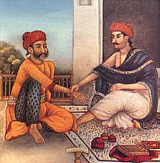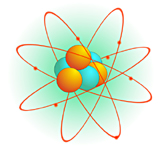Āyurveda
The cosmic evolution
Abstract
This chapter is taken from a book on Āyurveda, written by a wise physician practising in Sri Lanka. It describes in very concrete detail abstract Vedic concepts of Āyurvedic medicine. It also explores briefly how atomic sub-particles could be understood as per Āyurvedic tenets.
The Vedas are the basic scriptures of the Hindus. They study the totality of nature from two directions. That is from:
i. the unmanifest to the manifest and
ii. from the manifest to the unmanifest.
It is a ‘blending’ of both the holistic and the analytical approach. The Nyāya Vaiśeṣika, the Sānkhya philosophy and yoga of the Vedic science are closely associated with Āyurveda. Their concepts are applicable to everyday life when understood in the correct perspective.
A knowledge of the Sānkhya concept of cosmic evolution is an essential pre-requisite to understanding Āyurveda in depth. Since an in-depth explanation of this concept cannot be covered here, I have made an attempt to present it in an abridged form.The Sānkhya philosophy could be regarded as the earliest school of thought to postulate a continuous step-wise evolution of the universe as a result of the union of two eternal entities. It states that the eternal and incorporeal factor, known as Puruṣa or Ātmā, triggers primordial matter, known as Mūla prakṛti to commence the continuous process of evolution. Ātmā (Puruṣa) is the animating factor and the ‘Cosmic Psyche’. It is interesting to note that Sānkhya philosophers were the first to explain cosmic evolution considering Puruṣa as the masculine principle and Mūla prakṛti as the feminine principle and that the evolution takes place from the Mūla prakṛti. The Puruṣa is non-material and the Mūla prakṛti is material. The cosmic evolution is, in brief, differentiation within the integrated (saṁsṛīṣṭaviveka) subject to a ‘definite law’ and conforms to a definite pattern known as the ‘Pariṇāmakramaniyama’.
A comparative study of the Ātmā and Mūla Prakṛti
Ātmā or Puruṣa |
Mūla Prakṛti |
| Nitya (eternal) | Nitya (eternal) |
| Apariṇāmī (that which will not evolve) | Pariṇāmī (that which will evolve) |
| Neither an evolute nor an evolvent | Not an evolvent but an evolute |
| Aprasavadharmiṇī (that which will not give birth) | Prasavadharmiṇī (that which will give birth) |
| Repository of unbounded awareness. Unified field of all the laws of nature |
Undifferentiated primordial matter-stuff Primordial Nature. Primordial ‘foam’ |
| The Vedic science identifies it as pure Intelligence or pure Consciousness. A non-material factor that enters the primordial Matter to trigger off differentiation within it thus commencing the process of cosmic evolution | State of least excitement of the triguṇas: sattva, rajas and tamas. A transcendental field of existence. No evolution takes place but waits to be triggered by Ātmā |
Ātmā as Pure Consciousness is known as Paramātmā. Ātmā *that is present in every organism is known as Jīvātmā (1).
The Sānkhya philosophy postulates that the cosmos and the human system are linked with the same basic components. It states that the microcosm represents the macrocosm. Further, it analyses the phenomenal world under ‘nine entities’ (nava-dravyas), namely,
1. Ākāśa
2. Vāyu
3. Tejas
4. Ap
5. Pṛthivi
6. Ātmā
7. Manas
8. Kāla
9. Dik (2).
The cosmic time-space (kāla and dik) complex owes its existence to the conscious mind (Manas) of the ‘observer’ who is also the ‘participant’ in the overall ‘drama of evolution’ in time (kāla) and space (dik).
The term Ākāśa has two specific interpretations which should be well understood. They are:
I. That which is the non-material space in which infinitesimal units of mass ‘float’;
II. That which is the all material and pervasive, undifferentiated, infinitesimal unit of mass or the basic unit of matter (bhūtādi) or the tamas of the mūla prakṛti. They await differentiation which then results in the diverse forms of beings (dravya), properties (guṇa) and effects (karma) which could be grouped as being similar (sāmānya) and dissimilar (viśeṣa).
Commencement of cosmic evolution
During the pre-evolution phase, the mūla prakṛiti, remains undifferentiated. The inherent threefold tendencies, sattva, rajas and tamas, (trigunas), of the mūla prakṛiti are in a state of equilibrium or least ‘excitement’.
The ‘union’ of the eternal, non-materialpure consciousness known as the Puruṣa (the ‘masculine principle’), but devoid of consciousness, disturbs the state of ‘least excitement’ of the triguṇas and triggers cosmic evolution.
The tendencies of sattva, rajas and tamas could be explained, in brief, as follows:
| Sattva guṇa | The essence that manifests in a phenomenon. The tendency to manifest. Serves as the medium for the manifestation and reflection of intelligence. Devoid of negative tendencies and is always pure. Tendency to stabilise rajo and tamoguṇas. |
| Rajoguṇa | It is energy; dynamic. Tendency to do work or overcome resistance and tamoguṇa. |
| Tamoguṇa | Mass or inertia. Counteracts rajoguṇa. Known as bhūtādi or kāraṇa ākāśa, the undifferentiated ‘field’ or matter-stuff in a state to be charged by ‘packet of energy units’ from rajoguṇa resulting in differentiation and in the formation of the pañcabhūtas. |
Once the state of equilibrium is disturbed, the triguṇas break up their uniform diffusion, Affinity comes into play. This leads to unequal aggregation and relative preponderance of one guṇa over the others. Thus the triguṇas continue to combine, separate and re-combine in various modes of formative combinations amongst them.
The threefold tendencies, sattva — rajas — tamas permeate the cosmic evolution and at no stage or time could there be a single guṇa without the other since they are always interdependent.
The unstable state of the triguṇas results in a series of reactions conforming to a specific pattern. The first manifestation is the Buddhi or Mahat. Buddhi could be interpreted as the Intellect or ‘cosmic will’ in operation that satisfies the urge for manifestation created by the disturbed state of equilibrium of sattva, rajas and tamas.
This is followed by the second evolute the Ahaṃkāra, the Ego or ‘I’ consciousness. It is that which identifies the individuality of every phenomenon. From this point onwards the sequence of evolution could be better explained by considering the ahaṃkāra, with the triguṇas in it, to bifurcate the series of cosmic evolution.
One series of evolution indicates the manifestation of Manas** (mind), the pañca jñana indiyas (the five sensory organs) and the pañca karma indiyas (the five motor organs). Such a series of evolution comes into being from sāttvic ahaṃkāra influenced by rājasic ahaṃkāra (see Figure 1).
The second series of evolution describes the genesis of matter which behaves as energy, vibrations or waves brought about by the tamasic ahaṃkāra (bhūtādi) being charged by increasing units of rājasic ahaṃkāra as energy. Tāmasic ahaṃkāra forms the substratum or the first ‘stadium’ for objective manifestations. The basic ‘unity beyond all diversities’ that we comprehend is intrinsically the mūla prakṛiti which permeates as bhūtādi (tamas) or the precursor or forerunner of the ‘cosmic state of matter’.
The pañca tanmātrās
The tāmasic ahaṃkāra (bhūtādi) which exists as an absolutely homogeneous and absolutely inert quantum or mass in cosmic space, when charged by rajas with specific units of energy, results in the manifestation of a series of ‘infra-atomic particles’ known as tanmātrās. These are five (pañca) in number and possess definite physical characteristics depending on the addition of each unit of energy received from rajas.
The manner in which the fivefold characteristic ‘packets of energy’ (pañca tanmātrās) appear, in order of succession, is briefly explained as follows:
1. The first is the potential of ‘sound stimuli’; possesses physical energy of vibration and is known as the sabda tanmātrā.
2. The second is the potential of ‘tactile stimuli’; possesses physical energy of mechanical pressure or impact, and is known as the sparśa tanmātrā. In addition to this property it also possesses the potential of the first in a latent form.
3. The third is the potential of ‘light stimuli’; possesses heat, light, colour and radiation and is known as the rūpa tanmātrā. In addition, it also possesses the characteristics of the second and the first in a latent form.
4. The fourth is the potential of ‘taste stimuli’; possesses the potential of viscous attraction and taste. It is known as the rasa tanmātrā. In addition, it also possesses the characteristics of the third, second and first in a latent form.
5. The fifth is the potential of ‘smell stimuli’; possesses the potential of cohesive effect and smell. It is known as the gandha tanmātrā. In addition, it also possesses the characteristics of the fourth, third, second and first in a latent form.
Sound, touch, light, taste and smell are said to be the specific and innate properties of the above-mentioned tanmātrās respectively.

The Pañcabhūta Paramāṇu
The next phase of objective manifestation is the appearance of the five-fold complex tanmatric structure. They are known as the pañcabhūta Paramāṇus. They evolve by way of receiving an addition of mass and by a sort of condensation of the tanmātrās. If one considers tanmātrās to be infra-atomic particles, the pañcabhūta paramāṇus could be visualised to be atomic in form.
Each of the five bhūta paramāṇus possess all the five tanmātrās within them. The five bhūta paramāṇus differ from one another depending on the particular tanmātrā which forms the ‘radical’ or ‘nucleus’ of its structure. The pañcabhūta paramāṇus, in their order of mass and condensation from the subtle state to a less fine manifestation, are identified as:
1. Ākāśa paramāṇu,
2. Vāyu paramāṇu,
3. Teja paramāṇu,
4. Ap or Jala paramāṇu and
5. Pṛthvi paramāṇu.
A simplified presentation of their formation is as follows:
1. The sabda tanmātrā as the radical, along with the other tanmātrās, forms the Ākāśa paramāṇu.
2. The sparśa tanmātrā as the radical, along with the other tanmātrās, forms the Vāyu paramāṇu.
3. The rūpa tanmātrā as the radical along with the other tanmātrās, forms the Teja paramāṇu.
4. The rasa tanmātrā as the radical, along with the other tanmātrās, forms the Ap or Jala paramāṇu.
5. The gandha tanmātrā as the radical, along with the other tanmātrās, forms the Pṛthvi paramāṇu.
The Sānkhya concept of cosmic evolution states that the pañcabhūta paramāṇus go to form the grosser series of ‘molecules’ known as the pañcabhūtas or the ‘Pentad cosmic states of matter’.
The pañcabhūta
The pañcabhūtas or the ‘Pentad cosmic states of matter’ could be viewed as constituents of matter in terms of gravitation or gurutva (tamas) and energy (rajas) concentration. They are five in number and every bhūta is made up of all the five bhūta paramāṇus. The pañcabhūtas are named as:
1. Ākāśa bhūta,
2. Vāyu bhūta,
3. Teja bhūta,
4. Ap bhūta and
5. Pṛthvi bhūta.
The manifestation of the pañcabhūtas also follows a similar pattern when compared to the formation of the five paramāṇus. A simplified description of the pañcabhūtas from the subtler to the grosser state of manifestation is as follows:
1. The ākāśa paramāṇu as the radical, along with the other paramāṇus, forms the ākāśa paramāṇu bhūta. This is responsible for the subtlest and the most rarefied state of matter. It is vibrant.
2. The vāyu paramāṇu as the radical, along with the other paramāṇus, forms the vāyu bhūta. This is responsible for the gaseous manifestation and movement. It may be described to exhibit a form of electro-magnetic field or a wave effect.
3. The teja paramāṇu as the radical, along with the other paramāṇus, forms the teja bhūta. This is responsible for the manifestation of heat and light. It is radiant.
4. The ap paramāṇu as the radical, along with he other paramāṇus, forms the ap bhūta. This is responsible for the liquid manifestation, cohesion and taste.
5. The pṛthvi paramāṇu as the radical, along with the other paramāṇus, form the pṛthvi bhūta. This is responsible for the solid manifestation with marked gravitation and smell.
The pañcabhūtas show their affinity between the five human senses in the following manner. The ākāśa bhūta is related to the sense of hearing; the vāyu bhūta to the sense of touch; the teja, ap and pṛthvi exhibit their affinity to the sense of sight, taste and smell respectively (3,4).
Man has been described in different ways. Yet his complexity has been ultimately identified as a conscious agent (Cetāna dhātu puruṣa). It could be stated that the entire ‘matter — space — time’ matrix of the cosmos owes its existence to the conscious mind. Being of pañca bhūtic origin, ‘man’ as an ‘observer’ and as a ‘participant’, responds and reacts to the ever changing environment. Such activities are made possible through the sensory organs (jñāna indiyas) and motor organs (karma indiyas) directed by the conscious mind (manas) with its threefold tendencies — sattva, rajas and tamas.
The Sānkhya concept of cosmic evolution is a philosophy of practical importance for both the élite and common man. It reflects the profound truth of ‘unity in diversity’. Matter and energy, the inanimate and the animate, the body and mind and all such duality ultimately fades away into oneness.
References
1. Caraka Śarnra 4th chapter.
2. Caraka Sūtra 1:48.
3. Caraka Sarīra 1:17; 43, 53, 60-7; 75, 76, 80, 83.
4. Seal, BN. The Positive Science of the Hindus; pp. 2-56.
*Note: The word ‘soul’ does not convey the concept of Ātmā as enunciated in the Sānkhya philosophy. I shall therefore continue to use the original Sanskrit term Ātmā in this article.
** Hypothetically, this would have been the point of cosmic evolution at which organisms evolved — Author.
(Courtesy: Treatise on Āyurveda. Colombo: Vijitha Yapa Publications; 2004, pp. 9-18.)
Share with us (Comments,contributions,opinions)
When reproducing this feature, please credit NAMAH,and give the byline. Please send us cuttings.









